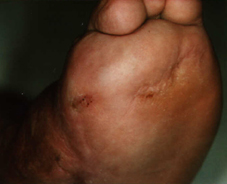Practice of Diabetology Carola Zemlin M.D., Wanzleben/Germany
Anamnesis:
61 years old, male, type 2 diabetes mellitus, duration of 25 years, insulin therapy since only one year with 3x normal and NPH insulin at night.
1993 amputation of the 1st and 2nd left toe because of infection. In February 1999 13 days of stay in a hospital for internal desease, 12 days surgery, metatarsectomy of parts of the 3rd and 4th metatarsal bone by reason of diabetic neuropathic osteo-arthropathy with destruction of the metatarsophalangeal articulation joints and sequestration. Referral to our ambulance because of open wounds plantar and dorsal for further therapy.
Local pre-therapy:
Until metatarsectomy with urea ointment and irrigation with Ringer´s solution.
Actual findings at 1999/03/18:
Plantar a residual wound in granulation-phase 1.3 x 2.4 cm; dorsal a plane lesion 1.2 x 0.7 cm, granulation-phase. Both lesions stage 1 according to WAGNER. The left foot is heavy deformed and overwarmed, medial border of the foot prominent. The X-ray pictures show additionally a fracture of the 5th metatarsal bone. The diabetic neuropathic osteo-orthropathy is type 1 according to SANDERS. Classical symptomes of polyneuropathy, no indication for arterial occlusive disease, onychomycotic nails. Because of instability of the foot we manufactured a neuropathy adapted cast made of polyurethane up to the knee, that could be removed at night and for dressing change.
The local wound treatment is carried out with sterile LIGASANO® stripes, the application is made by the patient himself. In the meantime it amounts once more to sequestration medial. The lesion developed from this heals after 7 days of wound treatment with LIGASANO® white.
Study about the use of LIGASANO® white as initial wound dressing at foot disease caused by diabetics, of Carola Zemlin, M.D., internist/diabetologist. For the evaluation of the study please click here.



